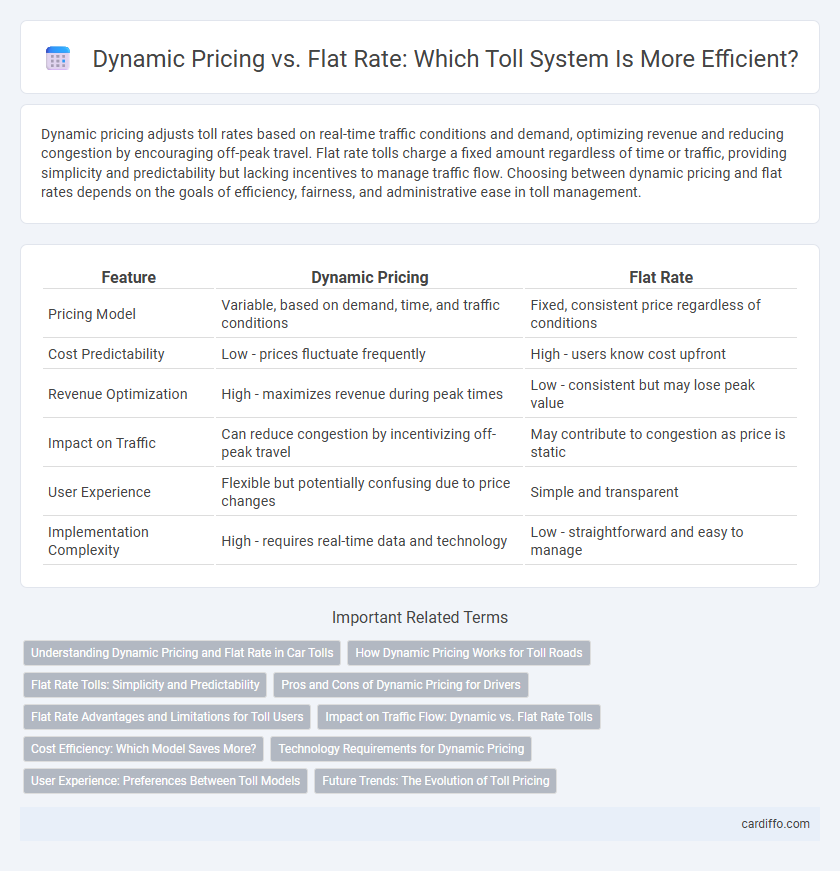Dynamic pricing adjusts toll rates based on real-time traffic conditions and demand, optimizing revenue and reducing congestion by encouraging off-peak travel. Flat rate tolls charge a fixed amount regardless of time or traffic, providing simplicity and predictability but lacking incentives to manage traffic flow. Choosing between dynamic pricing and flat rates depends on the goals of efficiency, fairness, and administrative ease in toll management.
Table of Comparison
| Feature | Dynamic Pricing | Flat Rate |
|---|---|---|
| Pricing Model | Variable, based on demand, time, and traffic conditions | Fixed, consistent price regardless of conditions |
| Cost Predictability | Low - prices fluctuate frequently | High - users know cost upfront |
| Revenue Optimization | High - maximizes revenue during peak times | Low - consistent but may lose peak value |
| Impact on Traffic | Can reduce congestion by incentivizing off-peak travel | May contribute to congestion as price is static |
| User Experience | Flexible but potentially confusing due to price changes | Simple and transparent |
| Implementation Complexity | High - requires real-time data and technology | Low - straightforward and easy to manage |
Understanding Dynamic Pricing and Flat Rate in Car Tolls
Dynamic pricing in car tolls adjusts fees based on real-time traffic conditions, congestion levels, and peak usage times to optimize road usage and reduce traffic jams. Flat rate tolls charge a fixed amount regardless of the time or traffic, offering simplicity but potentially leading to inefficiencies during peak hours. Understanding these models helps drivers and policymakers balance revenue generation, traffic flow, and commuter predictability on toll roads.
How Dynamic Pricing Works for Toll Roads
Dynamic pricing for toll roads adjusts fees based on real-time traffic conditions, congestion levels, and demand patterns to optimize traffic flow and reduce bottlenecks. Sensors and traffic data analytics determine variable toll rates that increase during peak hours and decrease during off-peak times, encouraging drivers to travel when roads are less crowded. This method improves road efficiency and maximizes revenue by aligning toll prices with current usage and congestion trends.
Flat Rate Tolls: Simplicity and Predictability
Flat rate tolls provide drivers with consistent and predictable costs, eliminating uncertainty in daily travel expenses. This straightforward pricing model enhances budget planning and reduces congestion caused by fluctuating toll fees. Many commuters and commercial drivers prefer flat rate tolls for their ease of use and financial stability.
Pros and Cons of Dynamic Pricing for Drivers
Dynamic pricing for tolls allows drivers to pay rates that fluctuate based on real-time traffic conditions, offering the advantage of potentially lower costs during off-peak hours. This pricing model encourages efficient road usage by reducing congestion, but it can also create uncertainty and unpredictability for drivers trying to budget their travel expenses. While dynamic pricing enhances traffic flow, it may disadvantage those with fixed incomes or inflexible schedules who face higher tolls during peak demand times.
Flat Rate Advantages and Limitations for Toll Users
Flat rate toll pricing offers predictability and ease of budgeting for users by charging a consistent fee regardless of traffic conditions or time of day. This model simplifies toll payment processes and reduces the need for complex monitoring systems. However, flat rates may lead to underutilization during off-peak hours and congestion during peak times, as they do not incentivize demand management or reflect real-time road usage.
Impact on Traffic Flow: Dynamic vs. Flat Rate Tolls
Dynamic pricing tolls adjust fees based on real-time traffic conditions, effectively reducing congestion by incentivizing off-peak travel and balancing road usage. Flat rate tolls charge a constant fee regardless of traffic volume, often leading to overcrowded highways during peak hours. Studies show dynamic pricing improves traffic flow by decreasing bottlenecks and minimizing delays compared to static flat rate systems.
Cost Efficiency: Which Model Saves More?
Dynamic pricing in toll systems adjusts rates based on real-time traffic demand, optimizing revenue and reducing congestion during peak hours, which can enhance cost efficiency for both operators and drivers. Flat rate tolls offer predictable expenses, simplifying budgeting for frequent users but may lead to inefficiencies during periods of low or high traffic volume. Studies show dynamic pricing generally yields greater cost savings by aligning toll charges with traffic flow, minimizing delays and maximizing infrastructure utilization.
Technology Requirements for Dynamic Pricing
Dynamic pricing for toll systems requires advanced technologies such as real-time traffic monitoring sensors, AI-powered algorithms for demand forecasting, and cloud-based platforms for instantaneous price adjustments. Integration with vehicle identification systems and mobile apps ensures seamless communication and enforcement. These technology requirements enable adaptive toll rates that optimize traffic flow and maximize revenue efficiency compared to static flat rate models.
User Experience: Preferences Between Toll Models
Dynamic pricing toll models enhance user experience by offering flexible rates based on real-time traffic conditions, reducing congestion and travel time. Flat rate tolls provide predictability and ease of budgeting, preferred by users who value simplicity and consistent costs. User preferences often depend on individual priorities such as cost certainty versus time savings.
Future Trends: The Evolution of Toll Pricing
Future trends in toll pricing emphasize dynamic pricing models that adjust rates based on real-time traffic data, congestion levels, and demand fluctuations to optimize road usage and reduce delays. Emerging technologies such as AI-driven algorithms and IoT sensors enable more precise and responsive toll management compared to traditional flat rate systems. This evolution supports enhanced revenue management, improved traffic flow, and greater user satisfaction in smart transportation networks.
Dynamic pricing vs Flat rate Infographic

 cardiffo.com
cardiffo.com